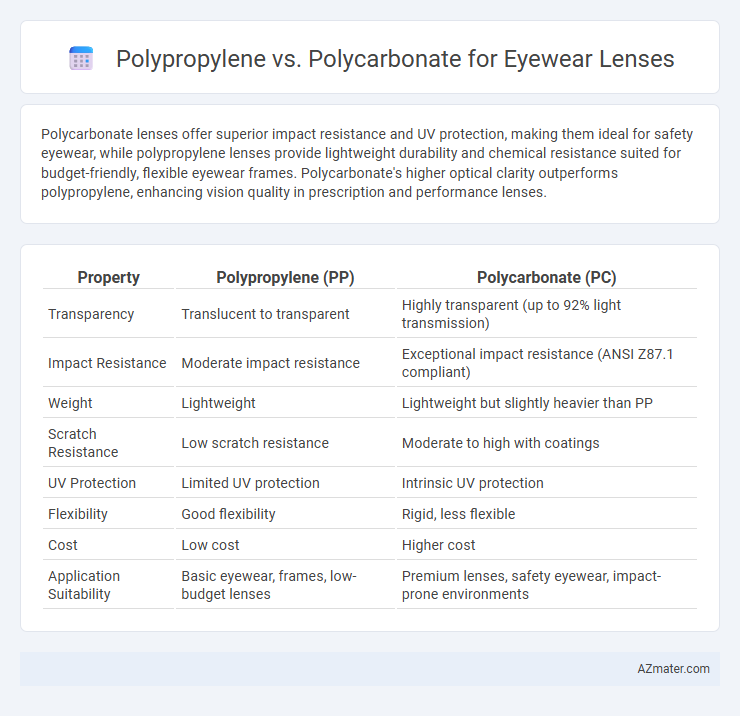Polycarbonate lenses offer superior impact resistance and UV protection, making them ideal for safety eyewear, while polypropylene lenses provide lightweight durability and chemical resistance suited for budget-friendly, flexible eyewear frames. Polycarbonate's higher optical clarity outperforms polypropylene, enhancing vision quality in prescription and performance lenses.
Table of Comparison
| Property | Polypropylene (PP) | Polycarbonate (PC) |
|---|---|---|
| Transparency | Translucent to transparent | Highly transparent (up to 92% light transmission) |
| Impact Resistance | Moderate impact resistance | Exceptional impact resistance (ANSI Z87.1 compliant) |
| Weight | Lightweight | Lightweight but slightly heavier than PP |
| Scratch Resistance | Low scratch resistance | Moderate to high with coatings |
| UV Protection | Limited UV protection | Intrinsic UV protection |
| Flexibility | Good flexibility | Rigid, less flexible |
| Cost | Low cost | Higher cost |
| Application Suitability | Basic eyewear, frames, low-budget lenses | Premium lenses, safety eyewear, impact-prone environments |
Introduction to Eyewear Lens Materials
Polypropylene and polycarbonate are two popular materials used in the production of eyewear lenses, each offering unique properties that impact durability and clarity. Polycarbonate lenses are known for their high impact resistance and lightweight nature, making them ideal for safety glasses and sports eyewear. Polypropylene lenses provide excellent chemical resistance and flexibility but are less commonly used due to their lower scratch resistance compared to polycarbonate.
What is Polypropylene?
Polypropylene is a thermoplastic polymer known for its lightweight, high chemical resistance, and flexibility, making it a durable choice for eyewear lenses. It offers excellent impact resistance and is less prone to cracking or shattering compared to other plastics, ideal for sports or safety glasses. Though not as optically clear as polycarbonate, polypropylene provides cost-effective, lightweight lenses with good UV protection properties.
What is Polycarbonate?
Polycarbonate is a highly impact-resistant thermoplastic polymer widely used in eyewear lenses due to its exceptional toughness and lightweight properties. It offers superior UV protection and shatter resistance compared to polypropylene, making it ideal for safety glasses and sports eyewear. Polycarbonate lenses also provide excellent optical clarity and are more scratch-resistant when treated with appropriate coatings.
Optical Clarity: Polypropylene vs Polycarbonate
Polycarbonate lenses provide superior optical clarity compared to polypropylene, offering better light transmission and reduced distortion. Polycarbonate's high refractive index allows for thinner, lighter lenses without compromising vision quality, making them ideal for eyewear demanding precision. Polypropylene lenses, while lightweight and impact-resistant, typically exhibit lower clarity due to their optical properties and are less effective in minimizing chromatic aberrations.
Impact Resistance Comparison
Polycarbonate lenses exhibit superior impact resistance compared to polypropylene, making them the preferred choice for safety eyewear and sports glasses. Polycarbonate's molecular structure provides high durability against shocks and drops, while polypropylene tends to crack under similar impact stress. Due to its enhanced toughness, polycarbonate lenses comply with ANSI Z87.1 standards for protective eyewear, offering better protection and longevity.
Weight and Comfort Factors
Polypropylene lenses weigh significantly less than polycarbonate, enhancing comfort for prolonged eyewear use. Polycarbonate offers superior impact resistance but is denser, which can cause added pressure on the nose and ears during extended wear. Lightweight polypropylene materials reduce fatigue and improve overall wearing comfort, making them ideal for everyday eyewear.
UV Protection Capabilities
Polycarbonate lenses provide superior UV protection by blocking 100% of harmful UVA and UVB rays, making them ideal for eyewear requiring maximum eye safety. Polypropylene lenses offer moderate UV protection but generally do not block UV rays as effectively as polycarbonate. For users prioritizing UV defense, polycarbonate is the preferred material due to its integrated UV-blocking properties.
Scratch Resistance and Durability
Polycarbonate lenses offer superior scratch resistance and enhanced durability compared to polypropylene, making them ideal for eyewear subjected to frequent impact and rough handling. Polycarbonate's high impact resistance and inherent toughness reduce the likelihood of lens damage, while polypropylene lenses are prone to scratching and wear over time due to their softer surface. Choosing polycarbonate ensures longer-lasting clarity and protection, especially in active or demanding environments.
Cost and Availability
Polypropylene lenses are significantly more cost-effective and widely available compared to polycarbonate, making them a popular choice for budget eyewear. Polycarbonate, while more expensive, offers superior impact resistance and optical clarity but is less common in mass-market eyewear due to higher production costs. Availability of polypropylene lenses spans multiple suppliers and retail outlets, ensuring faster supply chains and lower prices for consumers.
Choosing the Best Lens Material for Eyewear
Polycarbonate lenses offer superior impact resistance and UV protection, making them ideal for safety and sports eyewear, while polypropylene lenses excel in lightweight comfort and chemical resistance, suitable for everyday casual use. Polycarbonate's higher optical clarity and scratch resistance often justify its premium cost compared to polypropylene, which is less durable but more affordable. Selecting the best lens material depends on balancing factors like durability, weight, optical performance, and budget tailored to specific eyewear needs.

Infographic: Polypropylene vs Polycarbonate for Eyewear lens
 azmater.com
azmater.com